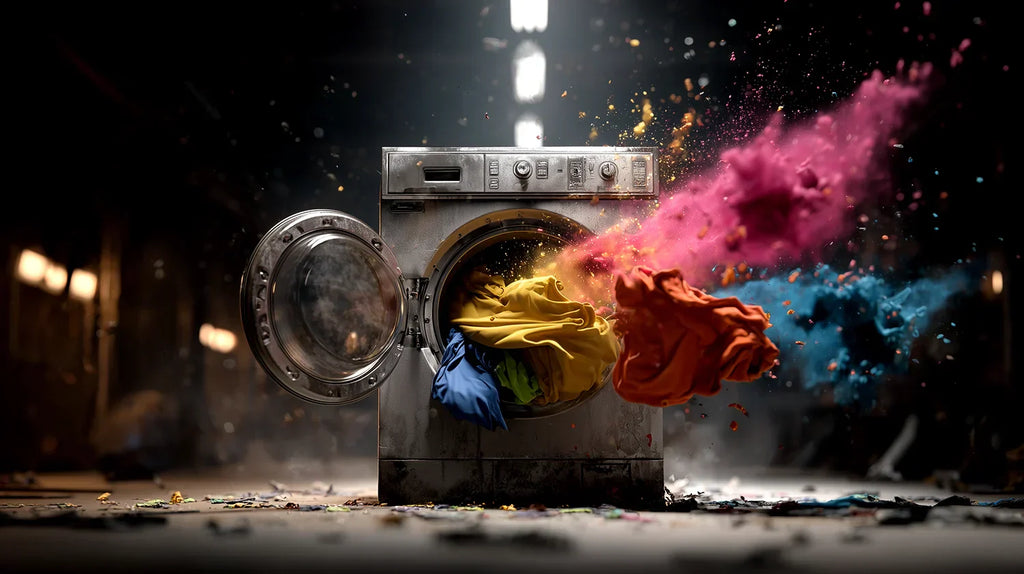💥 What’s the Most Durable Print Method?

🚀 Which Print Method Lasts the Longest? Real Results from 50 Washes
Not all t-shirt prints are made to last — and anyone who’s watched their favourite tee crack, peel, or fade after a few washes knows how frustrating that is. Whether you're running a merch drop, outfitting a team, or starting a custom t-shirt printing business, choosing the correct method is key to getting real value from your designs.
To determine which techniques truly withstand daily wear and washing, we conducted a head-to-head experiment involving 50 machine washes, heat drying, stretch testing, and sunlight exposure across four primary methods — DTG, DTF, vinyl, and screen printing. This article breaks down the results, explains how each process performs, and shows what it means to offer high-quality t-shirt printing in the UK.
🎯 What Do We Mean by “Durability?”
Durability in printwear isn’t just about surviving a single wash — it’s about colourfastness, flexibility, and how a print looks after 50 wears, not three. Whether you’re printing for fashion, sport, or retail, understanding what “long-lasting” really means is key. In this section, we’ll define how durability is measured and what customers expect from a high-quality garment.

A truly durable print resists fading, cracking, and distortion after repeated wear. Whether it’s DTG printed on cotton or a heat transfer applied to polyester, the results should hold through washing, ironing, and stretching. Our testing involved 50 complete wash cycles, tumble drying, UV exposure, and manual stretch testing. Each design followed our artwork guidelines to ensure consistency across methods.
Usage matters too. A custom hoodie worn casually will face different conditions than a printed uniform. We considered those use cases — from uniform printing and sports kits to custom-printed t-shirts — alongside everyday expectations for t-shirt printing in the fashion and retail industries.
Not all garments are designed for the same lifespan — and not all prints are either. Once you understand how durability is tested and defined, you’ll be better equipped to choose the correct method for your custom clothing or event wear.
🧾 Durability by Print Method & Purpose
Durability isn’t just about the print method — it’s about how and where the garment is used. A DTG print on a band tee worn casually once a week will face very different conditions than a DTF print on a polyester gym top washed after every session. In this section, we compare DTG, DTF, HTV, and screen printing through the lens of real-world use, examining how they perform under different conditions and which method best suits each job.
| Print Method | Durability Insight | Watch-Outs | Best Use Cases |
|---|---|---|---|
| DTG | Long-lasting when printed on 100% cotton, cured properly, and line-dried. Excellent colour detail and strong stretch tolerance. | Heat from tumble dryers can cause the print to become sticky and stick to itself. | Fashion apparel, streetwear, merch drops, brand launches with short-to-mid runs. |
| DTF | Highly durable, even with frequent washing. Strong adhesion on poly blends and mixed fabrics. | Slightly rubbery texture and less breathable on large, solid areas. | Sportswear, event tees, uniforms, and multi-colour logos on synthetics. |
| HTV | Can last well on minimal-use garments—sharp edges and bold colours when freshly applied. | Prone to cracking, lifting at edges, and fading with frequent use. | Names/numbers on kits, stag & hen tees, hobby prints, short-term items. |
| Screen Printing | Extremely tough on durable blanks. Handles abrasion and repeated laundering. Tolerates some stretch. | Costly for small runs and lacks detailed photorealistic artwork. | Industrial workwear, school uniforms, team kits, and extensive bulk runs (1000+). |
The most durable print method isn’t universal — it depends on how often the garment is worn, the type of fabric it’s made from, and how it's cared for. DTG holds up exceptionally well for casual wear and fashion prints when applied to quality cotton and washed correctly. DTF is better suited to activewear and poly blends that face frequent laundering. Screen printing still leads for commercial uniforms and high-impact use, but lacks flexibility for small or complex jobs. Matching the method to the use case is what ultimately delivers long-lasting results — especially if you're creating custom clothing for bulk t-shirt printing.
🔍 Key Factors That Affect Print Lifespan
Durability isn’t just about the print method — it’s the full equation: fabric, ink, pre-treatment, and how it’s washed. Even the best technique can fail without proper prep and garment care. Let’s explore the factors that can make or break print longevity.

🧵 Fabric Composition
The base fabric plays a huge role in how well a print holds up. DTG performs best on 100% ringspun cotton, where ink binds directly into the fibres. Cotton/poly blends can still print well, but often require DTF or screen printing for long-term results. Pure polyester typically resists water-based inks and demands special approaches like sublimation or DTF.
🧼 Wash Care
Hot washes, tumble dryers, and heavy ironing all accelerate wear — especially for delicate prints. Cold washes and line drying are gentler on both ink and fabric. Turning garments inside out before washing also helps preserve vibrancy and definition.
🎯 Print Technique Precision
A print’s lifespan depends on more than just the method — it’s also about how well it’s applied. For example, DTG relies on high-quality pretreatment and accurate ink saturation. If either step is off, even a premium printer will produce weaker results. DTF also demands proper curing and even transfer pressure.
👕 Usage Type
Think about how the garment will be worn. A fashion tee worn once a week needs less durability than a gym top washed daily or a branded polo worn five days a week on-site. Matching the technique to the usage scenario is key to getting prints that last.
By controlling these variables — especially fabric choice and washing habits — you can dramatically extend the life of your printed clothing. DTG prints on high-quality cotton blanks are built to go the distance when cared for correctly, whereas DTF performs reliably on poly blends and activewear that go through more frequent washes.
📊 Which Is Best for You?
Choosing the right print method isn’t just about price or popularity — it’s about purpose. Are you designing wearable artwork, launching a merch line, or printing uniforms that will be worn daily? Each method has strengths and limitations. Below is a simple comparison of the four print options, rated by durability, wash tolerance, and ideal use case.
| Print Type | Best For | Durability Rating | Wash/Stretch Tolerance |
|---|---|---|---|
| DTG | Soft fashion & art prints | ⭐⭐⭐⭐⭐ | High – Very High |
| DTF | Full colour on mixed fabrics | ⭐⭐⭐⭐☆ | Moderate |
| Vinyl | One-offs & one colour designs | ⭐⭐⭐☆☆ | Low – Moderate |
| Screen | Large bulk orders with limited colours | ⭐⭐⭐⭐☆ | High |
If you want studio-quality designs that hold up to real-life use — from wash to wear and everything in between — your print method matters. DTG delivers exceptional detail and softness for fashion-led pieces. DTF stands up to polyester-heavy sportswear. Vinyl works best for short runs and bold, minimal designs, while screen printing remains one of the most durable and cost-effective options for large volumes. Make your choice based on fabric, frequency of wear, and your brand’s goals — not just what’s cheapest. That’s how you build products people actually keep wearing.
🧼 Care Tips to Maximise Longevity
Even the best print won’t survive careless treatment. Stick to these basics:
- Wash inside-out, using cold or cool water
- Avoid tumble drying — air dry when you can
- Never use bleach or harsh detergents
- Don’t iron directly on the print
Think of it like skincare for your T-shirt — these small steps make a big difference. DTG prints, in particular, stay soft and vibrant for years when treated right.
🤔 Final Thoughts
So — after all the wash cycles, stretch tests, and side-by-side comparisons, who really comes out on top? This isn’t just theory. We’ve printed, worn, washed, and stretched each method to give you a no-nonsense verdict on what lasts — and why.
For long-term wear, DTG and screen printing both come out on top. DTG delivers soft, vivid results that hold up beautifully on cotton when correctly cared for, making it perfect for brands focused on a premium feel. Screen printing, meanwhile, offers industrial-level durability — it’s tough, bold, and thrives in high-volume production, though it’s less suited to fine details or multicolour artwork.
DTF strikes the best balance between colour performance and wash resilience. It bonds well to poly blends and activewear and resists fading even with frequent washing. But it does have drawbacks — the finish can feel thicker, and large prints may lack breathability, especially on lighter garments.
If ease of use is the top priority, DTG is the most user-friendly print method. Designers can upload a high-res image and print it exactly as it is — no colour separation, no worrying about how many shades are in the design. That simplicity makes it ideal for start-ups and one-off designs, though it still relies on the proper care and garment choice to maximise longevity.
HTV, while great for short runs and personalisation, shows its limits over time. It’s easy to apply, but it can crack, lift, or fade faster than the other techniques, making it a poor choice for frequent wear or high-impact use.
Ultimately, the best print method depends on your use case, garment, and customer. But with the right planning and the right expectations, any of these techniques can deliver prints that look good and go the distance.
🧠 Frequently Asked Questions
Whether you're printing for resale, workwear, or your first clothing line, these answers tackle the real questions about durability, print methods, and how to avoid common pitfalls.









